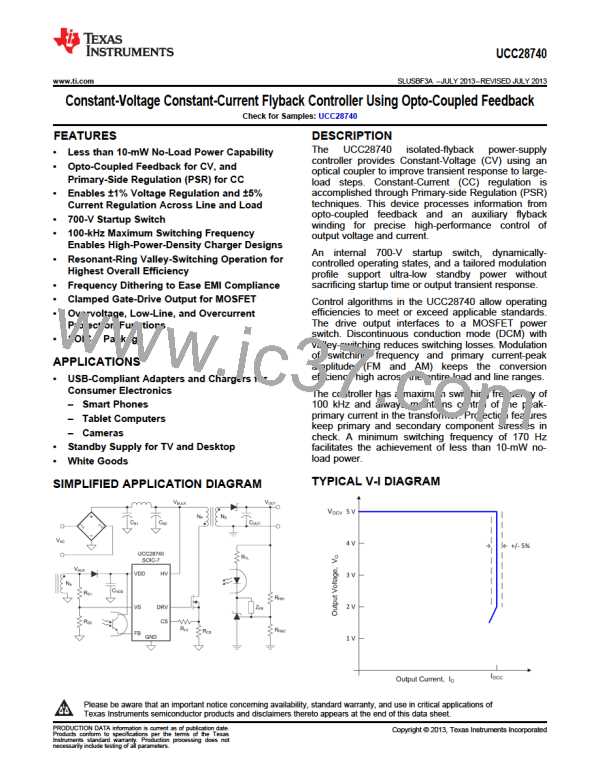UCC28740
www.ti.com
SLUSBF3A –JULY 2013–REVISED JULY 2013
The optocoupler transistor-output current ICE is proportional to the optocoupler diode input current by its current
transfer ratio, CTR. Although many optocouplers are rated with nominal CTR between 50% and 600%, or are
ranked into narrower ranges, the actual CTR obtained at the low currents used with the UCC28740 falls around
5% to 15%. At full-load regulation, when IFB is near zero, VFB is still approximately 0.4 V and this sets a minimum
steady-state current for ICE through RFB4. After choosing an optocoupler, the designer must characterize its CTR
over the range of low output currents expected in this application, because optocoupler data sheets rarely
include such information. The actual CTR obtained is required to determine the diode input current range at the
secondary-side shunt-regulator.
Referring again to Figure 19, the shunt-regulator (typically a TL431) current must be at least 1 mA even when
almost no optocoupler diode current flows. Since even a near-zero diode current establishes a forward voltage,
ROPT is selected to provide the minimum 1-mA regulator bias current. The optocoupler input diode must be
characterized by the designer to obtain the actual forward voltage versus forward current at the low currents
expected. At the full-load condition of the converter, IFB is around 0.5 µA, ICE may be around (0.4 V / RFB4), and
CTR at this level is about 10%, so the diode current typically falls in the range of 25 µA to 100 µA. Typical opto-
diode forward voltage at this level is about 0.97 V which is applied across ROPT. If ROPT is set equal to 1 kΩ, this
provides 970 µA plus the diode current for IOPT
.
As output load decreases, the voltage across the shunt-regulator also decreases to increase the current through
the optocoupler diode. This increases the diode forward voltage across ROPT. CTR at no-load (when ICE is
higher) is generally a few percent higher than CTR at full-load (when ICE is lower). At steady-state no-load
condition, the shunt-regulator current is maximized and can be estimated by Equation 30 and Equation 32.
IOPTNL, plus the sum of the leakage currents of all the components on the output of the converter, constitute the
total current required for use in Equation 7 to estimate secondary-side standby loss.
(32)
The shunt-regulator voltage can decrease to a minimum, saturated level of about 2 V. To prevent excessive
diode current, a series resistor, RTL, is added to limit IOPT to the maximum value necessary for regulation.
Equation 33 provides an estimated initial value for RTL, which may be adjusted for optimal limiting later during the
prototype evaluation process.
(33)
The output-voltage sense-network resistors RFB1 and RFB2 are calculated in the usual manner based on the
shunt-regulator reference voltage and input bias current. Having characterized the optocoupler at low currents
and determined the initial values of RFB1, RFB2, RFB3, RFB4, CFB3, ROPT and RTL using the above procedure, the
DC-bias states of the feedback network can be established for steady-state full-load and no-load conditions.
Adjustments of these initial values may be necessary to accommodate variations of the UCC28740, optocoupler,
and shunt-regulator parameters for optimal overall performance.
The shunt-regulator compensation network, ZFB, is determined using well-established design techniques for
control-loop stability. Typically, a type-II compensation network is used. The compensation design procedure is
beyond the scope of this datasheet.
REVISION HISTORY
Changes from Original (July, 2013) to Revision A
Page
•
Changed marketing status from Product Preview to Production Data. ................................................................................ 1
Copyright © 2013, Texas Instruments Incorporated
Submit Documentation Feedback
27
Product Folder Links: UCC28740

 TI [ TEXAS INSTRUMENTS ]
TI [ TEXAS INSTRUMENTS ]